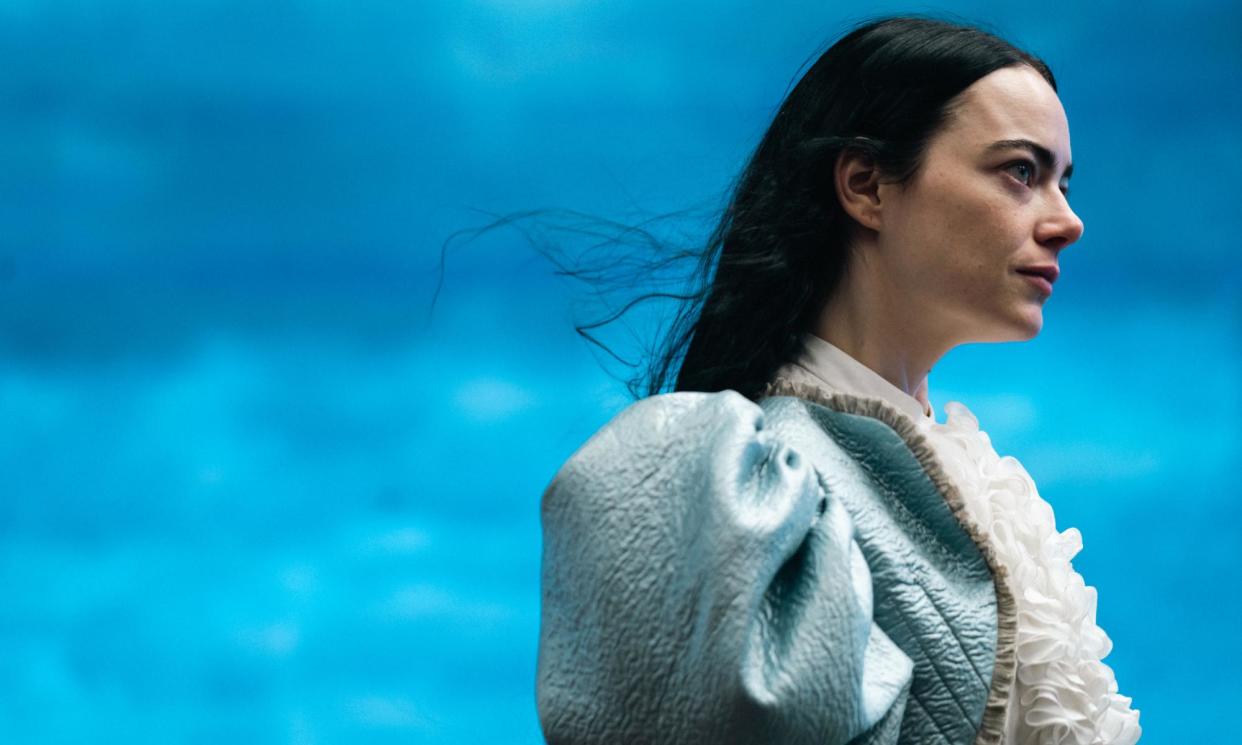Poor Things review – Emma Stone transfixes in Yorgos Lanthimos’s thrilling carnival of oddness

It may only be the third week of January, but it’s hard to imagine that there will be a funnier, filthier or more extravagantly peculiar film this year than Yorgos Lanthimos’s latest picture, his second feature film collaboration with star Emma Stone. To describe Poor Things, which is adapted by Tony McNamara (The Favourite) from the 1992 novel by Alasdair Gray, as creatively uninhibited hardly does justice to the wild, wild ride that this explosively inventive picture takes us on. Driven by a courageous and physically committed performance from Stone, the film follows her journey as Bella Baxter, at the start of the picture a barely verbal blank slate, who embarks on an autodidact voyage of discovery to become the ultimate self-made woman.
Like much in Poor Things, the period is impossible to pin down exactly. The story of Bella unfolds in a parallel past, a gothic, steampunk-infused Victoriana, a world that is distorted (literally – Lanthimos’s enthusiastic use of fisheye lenses warps the contents of the frame) by the patriarchal power disparities in society. Without giving away the specifics, the picture is a subversive spin on Mary Shelley’s Frankenstein, with the role of Bella’s creator and guardian taken by unorthodox genius Dr Godwin Baxter (Willem Dafoe). Called “God” by Bella, Godwin bears grotesque scars on his face and body resulting from his childhood experience as the subject of his father’s deranged scientific curiosity – an experience that failed to stymie his own rather baroque quest for empirical facts. When Godwin recruits eager student Max McCandles (Ramy Youssef) to keep a record of Bella’s accelerated progress, her grasp of language expands exponentially.
Bella’s journey is supported by a deliciously eccentric score that at one point sounds like a hippo mating with a harmonium
But Bella’s hunger for knowledge and experience is too voracious to be contained within the walls of Godwin’s mansion. She grasps the opportunity offered by caddish lawyer and man-about-town Duncan Wedderburn (a marvellously hammy Mark Ruffalo) and ventures forth from London, first to Lisbon, then by steamship to Athens and finally to a Parisian brothel. As Bella’s horizons broaden, so the look of the film alters to encompass her experiences. The chapter set predominantly in Godwin’s home is black and white, but once Bella ventures forth, the film shifts into colour. But not just any colour – there’s an uncanny, hyperreal quality to the palette that makes each frame look like a hand-tinted piece of Victorian postcard erotica.
It’s an alchemic combination, this continuing collaboration between Lanthimos and Stone, a working relationship that started with The Favourite and will continue with another feature film project, titled Kinds of Kindness. Two talents that could hardly be described as risk-averse in the first place (not for nothing did Lanthimos earn the status as the leading light of Greece’s “weird wave” with his surreal 2009 debut Dogtooth), together they unleash in each other an extra level of uninhibited artistic daring that, one suspects, must be rooted in an uncommon degree of mutual trust.
Nowhere is this more evident than in the physicality of Stone’s remarkable performance. And I’m not just talking about the nudity and the sex scenes, although since Bella approaches her body and her sexuality with the same delight and sense of adventure that she brings to the wider world, there is rather a lot of both. But Stone’s virtuoso use of her body – the way it inhabits space, the way she gradually masters her gangling, string-like limbs, the guilelessly open play of emotions in her face – is one of the most crucial elements in our experience of Bella’s journey.
That journey is supported by a deliciously eccentric score by Jerskin Fendrix. An uneasy, detuned four-note motif played on flayed violin strings opens the film and returns in various incarnations throughout, sounding at one point like a hippo mating with a harmonium. The gradual build of intricacy and sophistication in the music brilliantly mirrors Bella’s intellectual growth.
Equally important is the work of the film’s various design teams and Robbie Ryan’s ever-curious camera. Bella’s appetite for novelty is reflected in film-making that evokes a similar sense of wonder and discovery in the audience. From the quirky flamboyance of Holly Waddington’s costumes to the off-kilter production design by Shona Heath and James Price, Poor Things is an endlessly fascinating carnival of oddness. The production design details are particularly fascinating. The walls of Bella’s bedroom in Godwin’s house are hung with quilted ivory satin vignettes – an elegantly opulent twist on the padded cell.
The world outside, meanwhile, is heavily influenced by art nouveau design. But rather than the flora and fauna that inspired the original artists, here the design takes its cue from earthier themes. Look closely and you’ll notice that phallic imagery abounds, nestling between fallopian curlicues and vulvic buds. It’s a pervert’s playground full of subliminal smut. I can’t think of anywhere I would rather spend my time.

 Yahoo Movies
Yahoo Movies 
